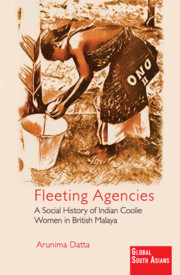Book contents
- Frontmatter
- Dedication
- Contents
- List of Tables
- List of Figures
- List of Abbreviations
- Acknowledgments
- Introduction
- 1 Coolie Women in the Empire’s Rubber Garden: Historical and Contextual Background
- 2 “Tapping” Resources: (Re)Figuring the Labor of Coolie Women on Estates
- 3 Managing “Partnerships”: Domesticity and Entrepreneurial Endeavors
- 4 Negotiating Intimacies and Moralities: Enticements, Desertions, Violence, and Gendered Trials
- 5 Becoming “Ranis”: Coolie Women as Rani Jhansi Regiment Recruits in World War II
- Conclusion
- Epilogue
- Glossary
- Notes
- Bibliography
- Index
5 - Becoming “Ranis”: Coolie Women as Rani Jhansi Regiment Recruits in World War II
Published online by Cambridge University Press: 31 December 2020
- Frontmatter
- Dedication
- Contents
- List of Tables
- List of Figures
- List of Abbreviations
- Acknowledgments
- Introduction
- 1 Coolie Women in the Empire’s Rubber Garden: Historical and Contextual Background
- 2 “Tapping” Resources: (Re)Figuring the Labor of Coolie Women on Estates
- 3 Managing “Partnerships”: Domesticity and Entrepreneurial Endeavors
- 4 Negotiating Intimacies and Moralities: Enticements, Desertions, Violence, and Gendered Trials
- 5 Becoming “Ranis”: Coolie Women as Rani Jhansi Regiment Recruits in World War II
- Conclusion
- Epilogue
- Glossary
- Notes
- Bibliography
- Index
Summary
We were real soldiers! I and many girls and women from the plantations joined the Rani Jhansi Regiment. I joined the Jan Baz Unit, the suicide unit. We trained well, I could shoot rifles, Bren guns, pistols, bigger guns, everything. I was not weak like you see me today. I was fit, strong and trained well for the fight. We were happy, fearless and full of energy.
—MeenachiPerumal,former soldier in the Rani of Jhansi RegimentThis is how Meenachi Perumal began her account of an exciting chapter in the lives of many coolie women—their service in the Rani of Jhansi Regiment (RJR), a regiment formed by Indian nationalist leader Subash Chandra Bose in 1943 across Japanese-occupied Southeast Asia, to fight for India's independence. Born in Bukit Keming estate, a rubber plantation in Malaya, Meenachi Perumal, like many other Indian women from the estates, joined the RJR in Japanese-occupied Malaya, between 1942 and 1945. Meenachi was sixteen years of age when she joined the regiment's suicide unit and was already a married woman.
Before carrying the story of Meenachi and the RJR forward, it is necessary to explain the context of this chapter and its place in this book. Between the 1920s and late 1930s, Indian coolie women in British Malaya found themselves central to power struggles between the British imperial governments and the Indian nationalists, as described in Chapter 4. These struggles were transformed by the entry of Japan into World War II in December 1941 and its rapid conquest of Singapore, British Malaya, and Burma in order to gain control of the region's rich resources of rubber and tin and deny their use to the Allies.
The loss of Singapore, renamed Syonan by the Japanese conquerors, was a humiliation for the British Empire and was later described by Winston Churchill, the British Prime Minister at the time, as “the worst disaster and largest capitulation in British military history,” thus revealing the psychological impact of the world's most powerful empire being easily defeated by a much smaller Asian army. Eighty-five thousand British, Australian, and British Indian soldiers surrendered to a Japanese army of only 30,000 men. Whilst Churchill was “stupefied” and “stunned” by the scale and rapidity of the defeat, Indian nationalists were encouraged and the Indian Independence League (IIL) perceived an alliance with the Japanese to defeat the British as the surest route to Indian independence.
- Type
- Chapter
- Information
- Fleeting AgenciesA Social History of Indian Coolie Women in British Malaya, pp. 125 - 150Publisher: Cambridge University PressPrint publication year: 2021



